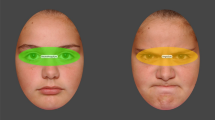Abstract
Adolescents with social anxiety disorder (SAD) often present distorted beliefs related to expected social rejection, coupled with avoidance of social stimuli including interpersonal interactions and others’ gaze. Social communication (SC) deficits, often seen in SAD, may play a role in avoidance of social stimuli. The present study evaluated whether SC impairment uniquely contributes to diminished or heightened attention to social stimuli. Gaze patterns to social stimuli were examined in a sample of 41 adolescents with SAD (12–16 years of age; 68% female). Unexpectedly, no significant relationship was observed between SC impairment and fixation duration to angry or neutral faces. However, SC impairment did predict greater fixation duration to happy faces, after controlling for social anxiety severity [adjusted R2 = 0.201, F(2, 38) = 4.536, p = 0.018]. Clinical implications are discussed, focusing on the potential utility of targeting SC impairments directly in light of the role of SC difficulties in youth with SAD.

Similar content being viewed by others
References
American Psychiatric Association (2013). Diagnostic and statistical manual of mental disorders (5th edn) American Psychiatric Publication, New York
Rapee RM, Spence SH (2004) The etiology of social phobia: empirical evidence and an initial model. Clin Psychol Rev 24:737–767
Borowski SK, Zeman J, Braunstein K (2016). Social anxiety and socioemotional functioning during early adolescence: the mediating role of best friend emotion socialization. J Early Adolesc 38(2):238–260
Weems CF, Costa NM (2005) Developmental differences in the expression of childhood anxiety symptoms and fears. J Am Acad Child Adolesc Psychiatry 44:656–663
Cartwright-Hatton S, Tschernitz N, Gomersall H (2005) Social anxiety in children: social skills deficit, or cognitive distortion? Behav Res Ther 43:131–141
Muris P, Merckelbach H, Damsma E (2000) Threat perception bias in nonreferred, socially anxious children. J Clin Child Psychol 29:348–359
Horley K, Williams LM, Gonsalvez C, Gordon E (2004) Face to face: visual scan path evidence for abnormal processing of facial expressions in social phobia. Psychiatry Res 127:43–53
Moukheiber A, Rautureau G, Perez-Diaz F, Soussignan R, Dubal S, Jouvent R, Pelissolo A (2010) Gaze avoidance in social phobia: objective measure and correlates. Behav Res Ther 48:147–151
Haller SP, Kadosh KC, Lau JY (2013) A developmental angle to understanding the mechanisms of biased cognitions in social anxiety. Front Hum Neurosci 7:846
Halls G, Cooper PJ, Creswell C (2015) Social communication deficits: specific associations with social anxiety disorder. J Affect Disord 172:38–42
Wieckowski AT, White SW (2017) Application of technology to social communication impairment in childhood and adolescence. Neurosci Biobehav Rev 74:98–114
Pickard H, Rijsdijk F, Happé F, Mandy W (2017) Are social and communication difficulties a risk factor for the development of social anxiety? J Am Acad Child Adolesc Psychiatry 56:344–351
van Steensel FJ, Bögels SM, Wood JJ (2013) Autism spectrum traits in children with anxiety disorders. J Autism Dev Disord 43:361–370
Towbin KE, Pradella A, Gorrindo T, Pine DS, Leibenluft E (2005) Autism spectrum traits in children with mood and anxiety disorders. J Child Adolesc Psychopharmacol 15:452–464
Corbett BA, Key AP, Qualls L, Fecteau S, Newsom C, Coke C, Yoder P (2016) Improvement in social competence using a randomized trial of a theatre intervention for children with Autism Spectrum Disorder. J Autism Dev Disord 46:658–672
Beidel DC, Turner SM, Morris TL (1999) Psychopathology of childhood social phobia. J Am Acad Child Adolesc Psychiatry 38:643–650
Spence SH, Donovan C, Brechman-Toussaint M (1999) Social skills, social outcomes, and cognitive features of childhood social phobia. J Abnorm Psychol 108:211–221
White SW, Schry AR, Kreiser NL (2014) Social worries and difficulties: Autism and/or social anxiety disorder? Springer, New York
Shechner T, Britton JC, Pérez-Edgar K, Bar-Haim Y, Ernst M, Fox NA et al (2012) Attention biases, anxiety, and development: toward or away from threats or rewards? Depress Anxiety 29:282–294
Armstrong T, Olatunji BO (2012) Eye tracking of attention in the affective disorders: a meta-analytic review and synthesis. Clin Psychol Rev 32:704–723
Spector IP, Pecknold JC, Libman E (2003) Selective attentional bias related to the noticeability aspect of anxiety symptoms in generalized social phobia. J Anxiety Disord 17:517–531
Pérez-Edgar K, Bar-Haim Y, McDermott JM, Chronis-Tuscano A, Pine DS, Fox NA (2010) Attention biases to threat and behavioral inhibition in early childhood shape adolescent social withdrawal. Emotion 10:349–357
Shechner T, Jarcho JM, Britton JC, Leibenluft E, Pine DS, Nelson EE (2013) Attention bias of anxious youth during extended exposure of emotional face pairs: an eye-tracking study. Depress Anxiety 30:14–21
Bradley BP, Mogg K, Millar NH (2000) Covert and overt orienting of attention to emotional faces in anxiety. Cogn Emot 14:789–808
Bradley BP, Mogg K, White J, Groom C, De Bono J (1999) Attentional bias for emotional faces in generalized anxiety disorder. Br J Clin Psychol 38:267–278
Waters AM, Mogg K, Bradley BP, Pine DS (2008) Attentional bias for emotional faces in children with generalized anxiety disorder. J Am Acad Child Adolesc Psychiatry 47:435–442
Tyson KE, Cruess DG (2012) Differentiating high-functioning autism and social phobia. J Autism Dev Disord 42:1477–1490
White SW, Maddox BB, Panneton RK (2015) Fear of negative evaluation influences eye gaze in adolescents with autism spectrum disorder: a pilot study. J Autism Dev Disord 45:3446–3457
Schofield CA, Inhoff AW, Coles ME (2013) Time-course of attention biases in social phobia. J Anxiety Disord 27:661–669
Egger HL, Pine DS, Nelson E, Leibenluft E, Ernst M, Towbin KE, Angold A (2011) The NIMH Child Emotional Faces Picture Set (NIMH-ChEFS): a new set of children’s facial emotion stimuli. Int J Methods Psychiatr Res 20:145–156
Silverman WK, Albano AM (1996). Anxiety Disorders Interview Schedule for DSM IV (Child and Parent Versions). Psychological Corporation
Wechsler D (2011). WASI-II: Wechsler Abbreviated Scale of Intelligence-Second Edition. Pearson
Constantino JN, Gruber CP (2012). Social Responsiveness Scale, Second Edition (SRS-2). Western Psychological Services
Laugeson EA, Gantman A, Kapp SK, Orenski K, Ellingsen R (2015) A randomized controlled trial to improve social skills in young adults with autism spectrum disorder: the UCLA PEERS® Program. J Autism Dev Disord 45:3978–3989
White SW, Schry AR, Miyazaki Y, Ollendick TH, Scahill L (2015) Effects of verbal ability and severity of autism on anxiety in adolescents with ASD: one-year follow-up after cognitive behavioral therapy. J Clin Child Adolesc Psychol 44:839–845
Rutter M, Bailey A, Lord C (2003). SCQ. The Social Communication Questionnaire. Western Psychological Services
Settipani CA, Puleo CM, Conner BT, Kendall PC (2012) Characteristics and anxiety symptom presentation associated with autism spectrum traits in youth with anxiety disorders. J Anxiety Disord 26:459–467
Leary MR (1983) A brief version of the Fear of Negative Evaluation Scale. Pers Soc Psychol Bull 9:371–375
Watson D, Friend R (1969) Measurement of social-evaluative anxiety. J Consult Clin Psychol 33:448–457
Clark LA, Watson D (1991) Tripartite model of anxiety and depression: psychometric evidence and taxonomic implications. J Abnorm Psychol 100:316–336
Heimberg RG, Hofmann SG, Liebowitz MR, Schneier FR, Smits JAJ, Stein MB, et al. (2014) Social anxiety disorder in DSM-5. Depress Anxiety 31:472–479
Carleton RN, Collimore KC, McCabe RE, Antony MM (2011) Addressing revisions to the Brief Fear of Negative Evaluation scale: measuring fear of negative evaluation across anxiety and mood disorders. J Anxiety Disord 25:822–828
Mogg K, Bradley BP, De Bono J, Painter M (1997) Time course of attentional bias for threat information in non-clinical anxiety. Behav Res Ther 35:297–303
Ollendick TH, Benoit K, Grills-Taquechel AE (2014) Social anxiety in children and adolescents. Wiley, New York
Garner M, Mogg K, Bradley BP (2006) Orienting and maintenance of gaze to facial expressions in social anxiety. J Abnorm Psychol 115:760–770
In-Albon T, Kossowsky J, Schneider S (2010) Vigilance and avoidance of threat in the eye movements of children with separation anxiety disorder. J Abnorm Child Psychol 38:225–235
Klin A, Jones W, Schultz R, Volkmar F, Cohen D (2002) Visual fixation patterns during viewing of naturalistic social situations as predictors of social competence in individuals with autism. Arch Gen Psychiatry 59:809–816
Price RB, Rosen D, Siegle GJ, Ladouceur CD, Tang K, Allen KB et al (2016) From anxious youth to depressed adolescents: prospective prediction of 2-year depression symptoms via attentional bias measures. J Abnorm Psychol 125:267–278
Benoit KE, McNally RJ, Rapee RM, Gamble AL, Wiseman AL (2007) Processing of emotional faces in children and adolescents with anxiety disorders. Behav Change 24:183–194
Gamble AL, Rapee RM (2009) The time-course of attentional bias in anxious children and adolescents. J Anxiety Disord 23:841–847
Cohen J (1992) A power primer. Psychol Bull 112:155–159
Weeks JW, Heimberg RG, Rodebaugh TL (2008) The Fear of Positive Evaluation Scale: assessing a proposed cognitive component of social anxiety. J Anxiety Disord 22:44–55
Wieser MJ, Pauli P, Weyers P, Alpers GW, Mühlberger A (2009) Fear of negative evaluation and the hypervigilance-avoidance hypothesis: an eye-tracking study. J Neural Transm 116:717–723
White SW, Ollendick T, Albano AM, Oswald D, Johnson C, Southam-Gerow MA et al (2013) Randomized controlled trial: multimodal anxiety and social skill intervention for adolescents with autism spectrum disorder. J Autism Dev Disord 43:382–394
Funding
This work was supported by the National Institute of Mental Health, Grant R34 [PI: Ollendick].
Author information
Authors and Affiliations
Corresponding author
Ethics declarations
Conflict of interest
The authors have no conflicts of interest.
Human and Animal Rights and Informed Consent
All study procedures were approved by the institutional review board for human subject research. All participants provided informed consent.
Rights and permissions
About this article
Cite this article
Capriola-Hall, N.N., Wieckowski, A.T., Ollendick, T.H. et al. The Influence of Social Communication Impairments on Gaze in Adolescents with Social Anxiety Disorder. Child Psychiatry Hum Dev 49, 672–679 (2018). https://doi.org/10.1007/s10578-018-0782-z
Published:
Issue Date:
DOI: https://doi.org/10.1007/s10578-018-0782-z




